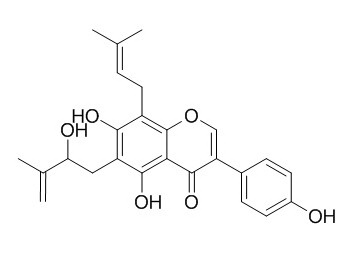Isoerysenegalensein E
Isoerysenegalensein E shows anti-estrogenic activity comparable to that of 4-hydroxytamoxifen, a typical estrogen receptor antagonist. It shows significant cytotoxicity against HL-60 cells, it induces apoptosis in HL-60 cells through activation of the caspase-9/caspase-3 pathway, which is triggered by mitochondrial dysfunction.
Inquire / Order:
manager@chemfaces.com
Technical Inquiries:
service@chemfaces.com
Tel:
+86-27-84237783
Fax:
+86-27-84254680
Address:
1 Building, No. 83, CheCheng Rd., Wuhan Economic and Technological Development Zone, Wuhan, Hubei 430056, PRC
Providing storage is as stated on the product vial and the vial is kept tightly sealed, the product can be stored for up to
24 months(2-8C).
Wherever possible, you should prepare and use solutions on the same day. However, if you need to make up stock solutions in advance, we recommend that you store the solution as aliquots in tightly sealed vials at -20C. Generally, these will be useable for up to two weeks. Before use, and prior to opening the vial we recommend that you allow your product to equilibrate to room temperature for at least 1 hour.
Need more advice on solubility, usage and handling? Please email to: service@chemfaces.com
The packaging of the product may have turned upside down during transportation, resulting in the natural compounds adhering to the neck or cap of the vial. take the vial out of its packaging and gently shake to let the compounds fall to the bottom of the vial. for liquid products, centrifuge at 200-500 RPM to gather the liquid at the bottom of the vial. try to avoid loss or contamination during handling.
Phytomedicine.2024, 128:155527.
J Ethnopharmacol.2024, 333:118415.
Research on Crops.2017, 18(2)
Analytical methods2019, 11(6)
Anticancer Res.2014, 34(7):3505-9
J.Acta Agriculturae Scandinavica2017, 571-575
Biochem Biophys Res Commun.2019, 518(4):732-738
J Pharm Biomed Anal2016, 118:183-194
Heliyon.2023, 9(6):e16138.
J Cell Physiol.2020, 10.1002
Related and Featured Products
Planta Med. 2006 Apr;72(5):424-9.
Induction of apoptosis by isoflavonoids from the leaves of Millettia taiwaniana in human leukemia HL-60 cells.[Pubmed:
16557456]
METHODS AND RESULTS:
We have isolated two new isoflavonoids, millewanin-F (1) and furowanin-A (2), together with five known isoflavonoids from the leaves of Millettia taiwaniana Hayata (Leguminosae) and examined their effects on the growth of human leukemia HL-60 cells. Among the isolated isoflavonoids, furowanin-A (2), warangalone (3), isoerysenegalensein-E (4), and euchrenone b10 (6) showed significant cytotoxicity against HL-60 cells. After treatment with three of the cytotoxic isoflavonoids, furowanin-A (2), warangalone (3), and Isoerysenegalensein E (4), fluorescence microscopy with Hoechst 33,342 staining revealed that the percentage of apoptotic cells with fragmented nuclei and condensed chromatin increased in a time-dependent manner. In addition, the activities of caspase-9 and caspase-3 were also enhanced in a time-dependent manner upon treatment with the isoflavonoids 2, 3, and Isoerysenegalensein E. Caspase-9 and caspase-3 inhibitors suppressed apoptosis induced by isoflavonoids 2, 3, and Isoerysenegalensein E.
CONCLUSIONS:
These results suggest that the isoflavonoids induced apoptosis in HL-60 cells through activation of the caspase-9/caspase-3 pathway, which is triggered by mitochondrial dysfunction.
Journal of Health Science, 2006 , 52 (2) :186-191.
AntiEstrogenic Activity of Prenylated Isoflavones from Millettia pachycarpa: Implications for Pharmacophores and Unique Mechanisms[Reference:
WebLink]
Phytoestrogens containing isoflavonoids are thought to exhibit preventative effects on estrogen-responsive diseases. Chemical modifications, such as prenylation, in biosynthetic processes enhance the structural variety of isoflavonoids and prompted us to carry out a structure-activity relationship study.
METHODS AND RESULTS:
We determined the estrogenic/anti-estrogenic activities and estrogen receptor (ER)-binding affinities of eight kinds of prenylated isoflavones isolated from Millettia pachycarpa (Leguminosae), and those of two kinds of non-prenylated compounds (genistein and daidzein). By comparing these compounds, the pharmacophores for estrogenic/anti-estrogenic activities were elucidated. None of the tested compounds (except genistein) were estrogenic on ligand-dependent yeast-two hybrid assay. On the other hand, 5 isoflavones showed distinct anti-estrogenic activity. Unexpectedly, the most potent antagonists, Isoerysenegalensein E and 6,8-diprenylorobol, showed anti-estrogenic activity comparable to that of 4-hydroxytamoxifen, a typical ER antagonist.
CONCLUSIONS:
This suggests that genistein became an antagonist after prenylation and hydroxylation. The pharmacophores providing genistein with strong anti-estrogenic activity were as follows: prenyl groups of the 6- and 8-positions on the A-ring, hydroxyl group of the 6-prenyl moiety or the B-ring (catechol form), non-cyclization of the prenyl group with the A-ring, and non-hydroxylation of the 8-prenyl group on the A-ring. The ER-binding affinities of the isoflavonoids were not sufficiently high to explain their potent antagonistic activities, thus suggesting 17β-estradiol-non-competitive mechanisms.
Nat Prod Commun. 2014 Jun;9(6):817-20.
Three new isoflavonoids from Erythrina caffra.[Pubmed:
25115087]
METHODS AND RESULTS:
Three new isoflavonoids, 5,7-dihydroxy-2',4'-dimethoxy-5'-(3-methylbut-2-enyl) isoflavanone (erycaffra A) (1), 5,7-dihydroxy-2',4'-dimethoxy-5'-(2-hydroxy-3-methylbut-3-enyl)isoflavanone (erycaffra B) (2), and 5,7-dihydroxy-6,8-di-(2-hydroxy-3-methylbut-3-enyl)isoflavone (erycaffra C) (3), were isolated from the stem bark of E. caffra Thunb., along with eight known compounds, namely, alpinumisoflavone (4), Isoerysenegalensein E (5), beta-amyrin (6), oleanolic acid (7), octacosyl-E-ferulate (8), triacontyl-4-hydroxycinnamate (9), n-tetracosyl p-coumarate (10) and octacosan-1-ol (11). The structures were determined on the basis of spectroscopic (1D, 2D-NMR) and MS data and by comparison with literature values.
Secologanic acid
Catalog No: CFN95028
CAS No: 60077-46-5
Price: $318/20mg
Poricoic acid G
Catalog No: CFN95056
CAS No: 415724-84-4
Price: $318/5mg
Torosachrysone 8-O-beta-gentiobioside
Catalog No: CFN95131
CAS No: 94356-13-5
Price: $318/5mg
Sphenanlignan
Catalog No: CFN95245
CAS No: 866347-36-6
Price: $318/5mg
5,6,7,3',4',5'-Hexamethoxyflavanone
Catalog No: CFN95376
CAS No: 74064-17-8
Price: $318/10mg
Naringenin 7-O-gentiobioside
Catalog No: CFN95435
CAS No: 104154-33-8
Price: $368/5mg
Oxytroflavoside E
Catalog No: CFN95464
CAS No: 1391144-84-5
Price: $318/5mg
trans-Cinnamoyl beta-D-glucoside
Catalog No: CFN95497
CAS No: 13080-39-2
Price: Inquiry(manager@chemfaces.com)
12beta-Acetoxy-3,7,11,15,23-pentaoxo-lanost-8,20-dien-26-oic acid
Catalog No: CFN95505
CAS No: 1309931-91-6
Price: $318/5mg
3''-O-Caffeoylhesperidin
Catalog No: CFN95564
CAS No: N/A
Price: $318/5mg



